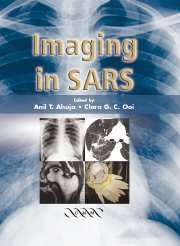Book contents
- Frontmatter
- Contents
- Contributors
- Preface
- 1 The Epidemiology of Severe Acute Respiratory Syndrome: A Global Perspective
- 2 The Role of Emergency Medicine in Screening SARS Patients
- 3 Severe Acute Respiratory Syndrome Outbreak in a University Hospital in Hong Kong
- 4 Imaging of Pneumonias
- 5 The Role of Chest Radiographs in the Diagnosis of SARS
- 6 Chest Radiography: Clinical Correlation and Its Role in the Management of Severe Acute Respiratory Syndrome
- 7 The Role of High-Resolution Computed Tomography in Diagnosis of SARS
- 8 The Role of Imaging in the Follow-up of SARS
- 9 Treatment of Severe Acute Respiratory Syndrome
- 10 SARS in the Intensive Care Unit
- 11 Imaging of Pneumonia in Children
- 12 Imaging and Clinical Management of Paediatric SARS
- 13 Imaging of SARS in North America
- 14 Radiographers' Perspective in the Outbreak of SARS
- 15 Implementation of Measures to Prevent the Spread of SARS in a Radiology Department
- 16 Aftermath of SARS
- 17 Update on Severe Acute Respiratory Syndrome
- Index
17 - Update on Severe Acute Respiratory Syndrome
Published online by Cambridge University Press: 27 October 2009
- Frontmatter
- Contents
- Contributors
- Preface
- 1 The Epidemiology of Severe Acute Respiratory Syndrome: A Global Perspective
- 2 The Role of Emergency Medicine in Screening SARS Patients
- 3 Severe Acute Respiratory Syndrome Outbreak in a University Hospital in Hong Kong
- 4 Imaging of Pneumonias
- 5 The Role of Chest Radiographs in the Diagnosis of SARS
- 6 Chest Radiography: Clinical Correlation and Its Role in the Management of Severe Acute Respiratory Syndrome
- 7 The Role of High-Resolution Computed Tomography in Diagnosis of SARS
- 8 The Role of Imaging in the Follow-up of SARS
- 9 Treatment of Severe Acute Respiratory Syndrome
- 10 SARS in the Intensive Care Unit
- 11 Imaging of Pneumonia in Children
- 12 Imaging and Clinical Management of Paediatric SARS
- 13 Imaging of SARS in North America
- 14 Radiographers' Perspective in the Outbreak of SARS
- 15 Implementation of Measures to Prevent the Spread of SARS in a Radiology Department
- 16 Aftermath of SARS
- 17 Update on Severe Acute Respiratory Syndrome
- Index
Summary
Introduction
The passage of time has healed some of the wounds inflicted by the deadly epidemic. The economy in Hong Kong and most of Asia has picked up and the communities have gone back to their daily activities. The masks and the gloves are off and people have gone back to their old habits with respect to personal hygiene and work practices. After all, old habits die hard.
However, severe acute respiratory syndrome (SARS) continues to lurk in the background and still causes a diagnostic dilemma. By the end of 2003/early 2004 (at the time of writing this chapter), there were five sporadic cases of SARS, two involving laboratory researchers and three outside the laboratory in Guangdong Province in China. Although the two laboratory cases (Taiwan, Singapore) were readily identified, the cases in Guangdong were definitively verified more than a week after the suspicion was raised. The clinical parameters, laboratory tests and history of contact in this patient were initially nebulous, highlighting the difficulty in the early diagnosis of this potentially fatal disease. Despite detailed contact, tracing the source of the infection was not definitively traced and it has been postulated that the source might have been civet cats as unpublished reports from Guangdong and Hong Kong have found similarities in the genetic sequences of the virus in the SARS patient and civet cats, which is a gourmet delicacy in southern China.
- Type
- Chapter
- Information
- Imaging in SARS , pp. 165 - 174Publisher: Cambridge University PressPrint publication year: 2004

